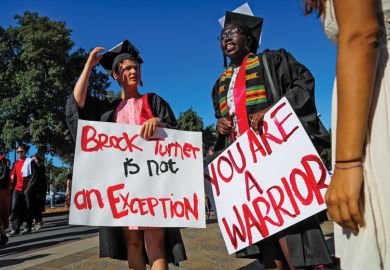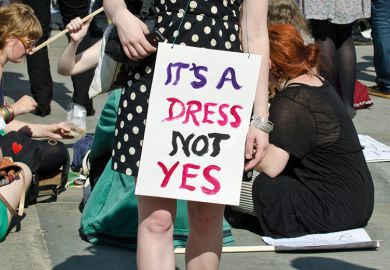A lack of confidence in being taken seriously and making complaints in open-plan offices are just some of the barriers stopping students reporting sexual harassment on university campuses.
Over the past year, I’ve led a team of students and academics asking why it’s so hard to talk about sexual violence and what might be done to encourage university communities to address the issues.
With the National Union of Students suggesting that one in five students experience some sort of sexual harassment during their first week of term, and Universities UK publishing new guidelines for universities on the issue, it’s clearly a huge problem across the higher education community.
Our research tried to get to grips with why sexual violence is so endemic on campuses. Perhaps uniquely, the data come from students, through students. We trained student leaders, using specialists in sexual violence from partner organisations and community practitioners, and then helped them gather data and stories from their peers.
The goal of the project was not to report students’ experiences directly but to identify what might be done to encourage both students and universities to address the issues more effectively.
So what can universities do?
First and foremost, our research identified that students almost uniformly lack knowledge of the support and reporting mechanisms available within their universities.
Although the universities taking part in the programme all had mechanisms for reporting sexual violence, we found that students aren’t always aware of these. Often, there’s not enough information available about external agencies that could help and, even where that information is available, cultural and institutional barriers prevent students from reporting incidents.
For example, stereotypes and myths around sexual violence, such as the idea that scantily clad women dancing in nightclubs are "asking for it", still pervade among the student body.
The procedures involved in reporting incidents are also not always conducive to encouraging victims to come forward, with some students reporting that they had been put off making a formal report by the fact that they would have to discuss such sensitive issues in an open-plan office.
Perhaps most worryingly, there is real confusion around what activities should be considered sexually violent or inappropriate.
Students are more likely to conceive of sexual violence as including physical force, leading some to admit that they wouldn’t necessarily report unwanted sexual touching for fear of being told they were overreacting. Student partners also reported feeling intimidated at times while promoting the research, with many being exposed to inappropriate "jokes" about the issue.
Ensuring all members of the academic community understand what does and does not constitute sexually violent behaviour is certainly a very good place to start. Perhaps the University of Oxford’s inclusion of compulsory sexual consent courses as part of its freshers’ programme wasn’t so wide of the mark, after all.
Based on these early results, there’s clearly a huge amount of work to be done across university communities. This includes raising awareness of sexual violence on campus and ensuring that suitable reporting mechanisms are visibly in place to encourage those affected to come forward.
But there’s reason for hope, too. Our project clearly demonstrated that when students are equipped and supported to confront the issue of sexual violence, they can do it incredibly effectively.
Our student partners’ ideas for collecting data that were used in the project – such as stalls, focus groups, events and films – were all the more effective because they were motivated by students themselves. They encouraged students to talk about the issues more openly, helping them to identify and put a name to sexual violence when it happens.
We are now looking to expand the programme to develop better protocols for training and awareness-raising around the issues, developing better systems for reporting on campuses and improving support for all members of the academic community.
Stephen Pihlaja is senior lecturer in stylistics at Newman University
The research project, Let’s Talk About Sex – Equipping Student Leaders to Address Sexual Violence on Campuses, was carried out by Stephen Pihlaja (Newman University), Kay Standing (Liverpool John Moores University), Ceri Davies (University of Brighton) and Polly Burton (Southampton Solent University) and was funded by the Higher Education Funding Council for England’s Social Innovation Fund.
Write for our blog platform
If you are interested in blogging for us, please email chris.parr@tesglobal.com
Register to continue
Why register?
- Registration is free and only takes a moment
- Once registered, you can read 3 articles a month
- Sign up for our newsletter
Subscribe
Or subscribe for unlimited access to:
- Unlimited access to news, views, insights & reviews
- Digital editions
- Digital access to THE’s university and college rankings analysis
Already registered or a current subscriber?










